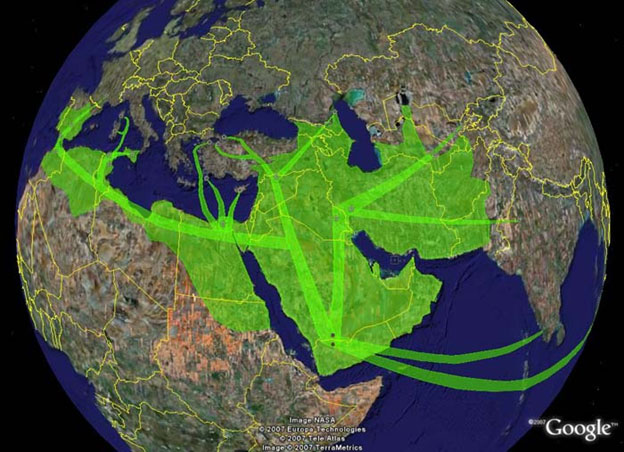Interactive popup. Assistance may be required.
Christianity is distributed on each continent shown.


This section will focus on the spatial distribution of some of the major religions of the world. The map below illustrates the distribution of some of the major world religions that you have learned about in the previous sections. Scroll over each religion in the legend to see it highlighted on the map.
→ Analyzing the Map: Answer the following questions based on the map above and your knowledge of the major religions of the world.
Interactive popup. Assistance may be required.
Christianity is distributed on each continent shown.


Christianity is the world’s most popular religion. The three largest branches of Christianity are Roman Catholicism, Protestantism, and Eastern Orthodoxy. All of these branches share the fundamental belief that Jesus of Nazareth is the savior of mankind. Each branch differs in its interpretations, rituals, and practices.
![]() Christianity has the most widespread distribution of any religion in the world. In the map below, click on the Middle East to see how Christianity spread throughout the world.
Christianity has the most widespread distribution of any religion in the world. In the map below, click on the Middle East to see how Christianity spread throughout the world.
With its origins in the Middle East, Christianity quickly spread as the disciples of Jesus and missionaries carried his teachings to places they traveled. Once the teachings reached the Roman Empire, the religion quickly spread. Continued migration and missionary work extended Christianity into Europe. European colonization and exploration led to the permanent settlement of Europeans in North and South America who brought the religious practices and beliefs of Christianity with them.
Islam, the second largest religion in the world, originated in the Middle East and spread into Africa, Asia, and Europe. Within 200 years after it was established, Islam had spread as far east as Indonesia. This distribution occurred as a result of Islamic armies that controlled North Africa, Southwest Europe, and Southwest Asia.

An ethnic religion is a religion that appeals primarily to one group of people who live in one place. Hinduism is the ethnic religion with the largest number of followers. Although it is the world’s third largest religion, 97 percent of all Hindus are concentrated in India. Another two percent are in Nepal, a neighboring country, and the remaining one percent is distributed throughout the world.
![]() In the map below, click on India to see the spread of Hinduism.
In the map below, click on India to see the spread of Hinduism.
Judaism is another example of an ethnic religion, but its distribution differs from other ethnic religions. After being forced from their homeland by the Roman Empire in 70 AD, Jews were forced to migrate to other regions of the world and practice their religion among people of other nationalities.
Jews were heavily persecuted by other nationalities for retaining a separate religion. During World War II, European Jews were severely victimized by the Nazis who confined them to concentration camps and exterminated them. Six million Jews died during the Holocaust. Many of those who survived migrated to Israel.
Read the following excerpt from the Arab-Israeli Timeline to understand how the state of Israel was formed.
| 1939-1945 | World War II and the Holocaust | Nazi Germany attacked and conquered most of Europe. Preceding and during the war, the Nazis persecuted Jews, eventually carrying out a genocide known as the Holocaust. This resulted in the murder of 6 million Jews. Although the Jewish population of the Palestine Mandate gave military support to Britain during the war, the British refused to allow the Jews to flee Nazi persecution and enter the Palestine Mandate. After the war, Jewish resistance in the Mandate was conducted against British refusal to allow the immigration of Jewish displaced persons, the remnant of European Jews , who had survived the Holocaust and had nowhere else to go. |
| 1947 | UN Partition Plan | In the midst of growing tensions between Arabs, Jews and the British, Britain announced its plan to pull out of the region and turned the question of sovereignty over to the United Nations. On November 29, 1947 the UN General Assembly voted to strike a compromise by partitioning the Palestine Mandate into an Arab state and a Jewish state and to internationalize the city of Jerusalem. Although it was less than they hoped for, the Jews accepted the partition, but the Arabs in the Palestine Mandate and the Arab states rejected the partition. Immediately after the UN partition vote, Arabs in the area, seeking to block Jewish statehood, attacked Jews. |
![]() In the map below, click on each symbol to see the migration of Jews to Israel after the end of World War II.
In the map below, click on each symbol to see the migration of Jews to Israel after the end of World War II.
"Today, there are about six million Jews who live in the United States, four million in Israel, and four million are dispersed throughout the world." --http://www.icsresources.org/content/factsheets/ArabIsraeliTimeline.pdf
In this lesson, you reviewed seven of the major world religions and learned a few characteristics about each. Most of the selected religions originated in the Middle East or India with the exception of animism, which had a spontaneous development. Most religions are now spatially distributed throughout the world.
Sources for image used in this section, as they appear top to bottom: